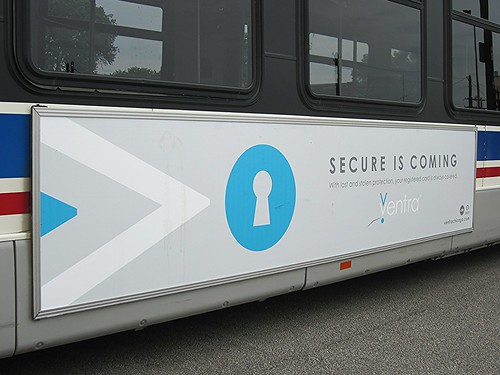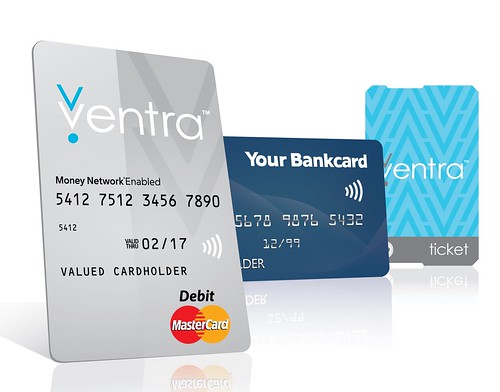CTA: Poor People Will Register Ventra Cards, Won’t Get Debit Card Hard Sell
10:22 AM CDT on August 2, 2013
A recent discussion of Ventra, the new fare payment system for the CTA and Pace, with CTA spokesman Brian Steele, has allayed some, if not all, of my concerns about the impact on low-income Chicagoans. The cost of a single-ride ticket will rise from $2.25 to $3. This price hike can be avoided by purchasing a reusable Ventra card for $5, which is refunded as a transit credit when you register the card. However, registering the card requires access to a phone, the Internet, or the CTA headquarters, which might be a barrier for very low-income individuals.
And if you purchase the card just before getting on the train, you need $7.25 in hand to pay for the card and the fare, unless you’re fortunate enough to be at a station with a payphone you can use for calling the toll-free registration number. That’s highly unlikely in a city where public phones are rare as hen’s teeth. It’s possible that some people might instead opt to repeatedly pay the $3 single-ride fare.
The Tribune recently reported that a study conducted for the CTA found that low-income people who buy a Ventra card are unlikely to register it, which would mean missing out on the $5 fare credit, as well as the ability to get a refund if the card is lost or stolen. However, when I asked CTA President Forest Claypool about this at a recent, unrelated press conference, he said the study found no such thing.
Another concern I had was that there’s no way for most people to buy a reusable Ventra card that doesn’t have the option of being activated as a prepaid Debit MasterCard, and the logo is printed on the corner of every card. The debit card has a number of associated user fees, which many low-income people can ill afford. It appeared that the registration process might be used to market the debit card to a captive audience, but Steele argued that’s not the case. Here’s an edited transcript of our conversation.
John Greenfield: I got the information about the internal study, which found low-income people are unlikely to register their Ventra cards, from a Tribune article. If not’s the case, what did the study find?
Brian Steele: You have to read the study, it’s a lengthy study, and somewhere on page 15 or 16 it talks about the assumptions that were made for the study. We had to come up with assumptions to estimate the number of people who may or may not register. We made two assumptions. The worst-case scenario: not a single person registers a Ventra card. Then we made another assumption that, I think it was, 89 percent registered and 11 percent wouldn’t. These are assumptions. They are not saying that 11 percent or ten percent or whatever the number may be will fail to register for the card. We believe, and our education and outreach efforts are designed to help make sure that this occurs, that people will register the Ventra card.
People who buy the single-ride ticket for $3 will be doing so because they choose to use that fare payment option. They have other options that will not cost them anything beyond their initial card purchase.
JG: Except that to purchase a single ride on the CTA you have to have $7.25 in your hand, correct? Because you need to buy the $5 card and then you need to load it with $2.25, so that’s not an insignificant amount of money for a very poor person. They might opt to just spend the $3 at one time, rather than invest that $7.25.
BS: That initial purchase is a one-time purchase, so that one time they have to spend more than they currently do so. When you buy a card, you’re not buying just a blank piece of plastic. You’re obviously buying fare value. The first time you purchase a card for $5 you register it with a quick phone call, or online, or however you choose to do it, and that $5 is applied.
JG: And then the thing is, you need to use a telephone, the Internet or show up in person to the CTA headquarters in order to register. It seems like those three things might be significant barriers to very low-income people.
BS: We don’t think they’re going to be significant barriers for a couple of reasons. The most main reason is, starting in a couple of weeks through the end of the year, we’ll be giving away tens of thousands of free Ventra cards in those communities. So we believe that on our initial push to get those out there, a lot of low-income people will come and take advantage that.
Again, we don’t think it’s going to be a barrier because people are, obviously, purchasing transit already. A lot of people are purchasing round-trip rides, not just single rides. Certainly people do purchase single rides, but it’s a very low percentage that put just $2.25 on a magnetic stripe card. Most people are putting more on there, even low-income people. So we don’t think it’s going to be a barrier of entry because it is a one-time purchase.
And we think if people are purchasing one ride at a time, and there are some people who do that, saving a little bit more and spending twice the amount that they normally do one time will not be a barrier of entry for the transit they need to do their everyday business. So will it be an additional amount that they initially spend? Yes, it will. But, again, that’s a one-time purchase, and it’s comparable to what they’d normally be paying for roundtrip ride on the CTA.
JG: You said the CTA will be handing out tens of thousands of fee-waived Ventra cards. That will be great for the first batch of Ventra customers, but is that something that you’ll be doing every year or so?
BS: Right now the plan is just to do it for the remainder of the year until Ventra is fully rolled out, which will be towards the end of the year. Again, a Ventra card is a permanent card, with the contactless technology. That’s probably the biggest change in the system. A lot of people are accustomed to disposable fare media. They’re accustomed to buying a card, which costs the CTA money to produce obviously, using it a couple of times and then throwing it away, leaving on the bus or the train. This will be something that you keep on you. And there’s a cost to producing that card, obviously. And that’s why there’s the initial $5 cost and, again, the value is completely refundable.
So that’s part of the education that we’re doing. This is not something that you pick up, put $2 on, and you have 20 of them lying in your drawer at home. That’s one of the things that we’re trying to shift away from. That’s a significant cost to us, a significant waste, that technology is outdated, and we’re seeing more and more failures on the system trying to process those cards. So, yeah, it will be a change in how people normally do business but it’s not different than how people are already conducting a lot of financial transactions. You know, people are using debit cards, people are using credit cards, people are using that kind of stuff on a daily basis for all types of other uses. We’re now bringing that to the transit realm.
JG: So the other question, in terms of equity, is the prepaid debit card. It’s impossible to by a regular Ventra card that does not also have the potential to be a prepaid debit card. It’s going to have the Debit MasterCard logo on it. Now, when you register the card, you have the three different options for registering it. Whichever way you register it, are you going to be asked if you want to activate the card as a debit card?
BS: Well, when you say, “Will you be asked,” it depends what method you’re using. If you’re registering on the phone, the customer will have to ask to pursue the prepaid debit option. The person on the phone will not say, “Hey! Would you like to sign up for it?”
On the website there’s, on the bottom of the screen there’s a button that says, “Would you like to register for the prepaid debit?” I just saw a mock-up of this the other day. So it requires a proactive effort on the part of the customer. You won’t be going through a series of menus to register the transit side of the card and then have something pop up saying, “Would you also like the prepaid debit?” It’s completely and totally optional, and a separate process from registering the transit card. The transit registration is boom-boom-boom. Name, address, phone number for verification purposes, done. Obviously, to register for the prepaid debit you have to fill out some more stuff.
JG: What happens, say, if I’m a homeless guy? I buy my card and I walk into the CTA headquarters and I want to register my card. What do I have to do?
BS: That is a good question. We’ll get whatever verification information we can. This individual might have the address of a shelter, the address of a relative, or a social service agency. The purpose of the registration is so we are able to provide information to the customer should they want it about their account, particularly a lost or stolen card, and the restoration of the balance. I’d have to get back to you on specifically what we require, but it would have to be something beyond just a name, because otherwise we’d have no way of contacting the individual.
In addition to editing Streetsblog Chicago, John writes about transportation and other topics for additional local publications. A Chicagoan since 1989, he enjoys exploring the city on foot, bike, bus, and 'L' train.
Read More:
Stay in touch
Sign up for our free newsletter
More from Streetsblog Chicago
Today’s Headlines for Thursday, April 26
The de-facto ban on riverwalk biking is back. What should we do about it?
In the short term, new signage is needed to designate legal areas for cycling on the path. In the long term CDOT should build the proposed Wacker Drive protected bike lane.






